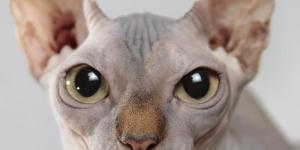Caring for a Manx Cat



See files for Cats
Can you imagine a cat with no tail? Surely you will find this a bit strange to see. In case you did not know, there are several breeds of cats that are characterized by a very short tail, or complete lack of it. This is the case of the manx cat.
If you have a manx at home, you will enjoy the docility of these felines, as they tend to be quite meek yet sociable, even with other pets. Purebred animals often need some extra care that crossbred cats may not require. For example, whether they have a genetic predisposition to develop certain diseases or the fur urges special maintenance. So, keep reading this AnimalWised article to discover all you need to know on caring for a manx cat.
Origin of the manx cat
The manx is native to the Isle of Man, a territory belonging to Great Britain. It is one of the breeds of cats that do not have a tail and, if they possess one, it scarcely reaches three centimeters. There are many legends surrounding this particularity, although the reality is that it is due to a genetic mutation that affects the formation of the spine.
The manx is an animal of great intelligence, tolerant with other pets and able to develop a strong emotional bond with their human family. The colors of their hair are varied in combination, and their body is round and chubby.
In itself, the care they need is fairly straightforward, except for special health care, as these cats are prone to suffer from spinal problems.

Entertaining a manx cat
The Manx is a pretty active cat, so you will need game sessions. They are excellent hunters, so chasing eye-catching toys is a good way to have fun together, while the cat gets in shape.
Climbing trees and and shelves is another one of their favorite pastimes. If you have a garden at home, it will only be necessary to ensure that the cat is not injured when climbing. If, on the other hand, you live in an apartment, it is recommended to get a cat tree or multi-level scratching post for them to climb safely.
Because of their sociable character and adrenaline-filled personality, it's a good idea to have another cat at home to keep the Manx company during their playtime and adventures.
Diet of a manx cat
Fortunately, the manx does not require a particular type of feed, as they are generally healthy and strong cats. A dry, moist or even homemade diet is good for this feline. The only thing to keep in mind is the ease with which they gain weight, so overfeeding is not a suitable alternative. For more information, do not miss our article in which we treat obesity in cats and show you how to avoid it.
Caring for their fur
This breed does not have particularly long hair, so there is not much care required in this area. A simple brushing once a week will suffice to eliminate all dead hair and give their coat shine. It is not necessary to bathe them if they are not dirty and you do not need to use any extra product for this purpose.
As in other breeds, be aware of possible parasites, such as fleas or ticks, or infections such as ringworm, to intervene in time.

They need enough space
A comfortable and warm bed, a container for food and another for fresh water, and their litter box are the basic items needed to keep your manx cat content. Remember to keep these items clean and to clean areas where the cat spends more time to prevent infections, mites and other discomforts.
Manx cat health
Usually, this is a healthy breed. In many cases, it is sufficient to have their vaccines up-to-date and to monitor any symptoms that indicate the presence of a possible disease. However, to offer the best care to the manx cat, the development of the spine should be monitored, due to the tendency to suffer malformation problems.
Due to the mutation caused by the lack of tail, they can end up suffering from several disorders, one of which is called 'Manx syndrome' or 'Manxness'.
What does it consist of?
The mutation of the spine can affect the cat from the moment they are born, causing malformations that are able to end the life of kittens after a few days of life. Because of this, it is recommended not to cross a short-tailed manx with another, to avoid the occurrence of this recessive gene. Ideally, they mate with some varieties that do have tails, such as the American shorthair, or are sterilized to avoid unwanted pregnancy.
If the kittens born with the malformation survive, throughout their life they will develop some ailment related to the mutation. Apart from spina bifida (which causes pain, inability to adopt a normal posture and problems in the nervous system), it is also possible that they suffer different disorders in the vertebrae and even in the pelvic area. These osseous malformations end up affecting the internal organs, so the cat will suffer from incontinence, digestive problems, constipation, hydrocephalus, among others. In extreme cases, paralysis is a possibility.
If you have a manx cat, it is best to let the vet monitor them from their kitten stage, so they can detect problems in good time.

If you want to read similar articles to Caring for a Manx Cat, we recommend you visit our Basic care category.








